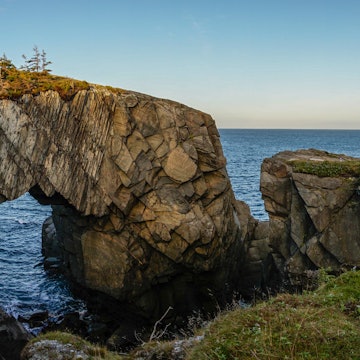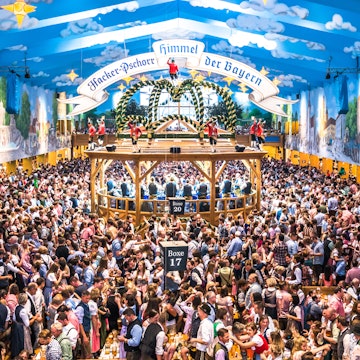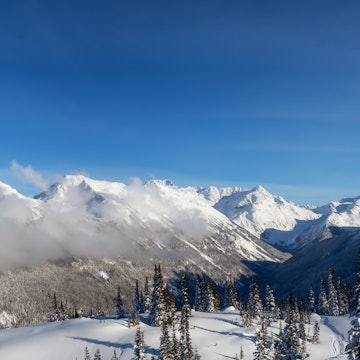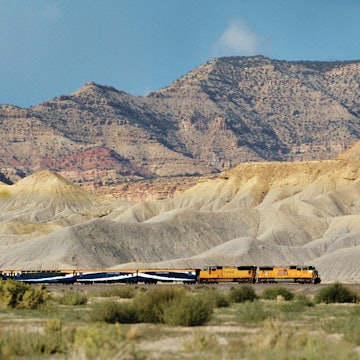
Get to know the Indigenous side of Edmonton, Alberta's capital city
Supported by

May 15, 2024 • 8 min read

Edmonton has a rich Indigenous history and contemporary culture © Brandon Mattice
Long before Edmonton was Alberta’s capital city (and the fifth largest city in Canada), it was a gathering place for Indigenous Peoples: Edmonton lies in the traditional territory of the Nehiyaw (Cree), Denesuliné (Dene), Anishinaabe (Saulteaux), Nakota Sioux (Stoney), Niitsitapi (Blackfoot) and Métis Peoples. While the Hudson’s Bay Company may have dubbed their trading post Fort Edmonton in 1795, each Nation had their own name for it. To the Cree, it was Amiskwacîwâskahikan (ah-miss-kwa-TSEE-was-kai-gan), which means Beaver Hills House; the Stoney called it Many Houses, and the Blackfoot called it Big Lodge.
Today, Edmonton has the second largest urban population of First Nations, Métis and Inuit People in Canada. Located within Treaty No. 6 territory and within the Métis homelands and the Métis Nation of Alberta Region 4, about six percent of the population of Alberta’s capital city identifies as Indigenous.
The city is a vibrant mosaic of Indigenous culture, offering many unique experiences that lend insight into the heritage and traditions of those who survived and thrived on the land for thousands of years before the first European settlers arrived. Here are some of the best ways to get to know the Indigenous side of Edmonton.
Get to know more of Edmonton with our first-timer's guide

Edmonton is one of the best cities to visit next year. See our full list of Best in Travel 2025 winners.
1. Visit the Indigenous Peoples Experience at Fort Edmonton Park
Fort Edmonton Park is the largest living history museum in Canada – a place to step back in time and experience what life was really like during different eras. This remarkable 30,000-square-foot interactive exhibit was developed in consultation with more than 50 Indigenous Elders, historians, educators and community members, and it was designed to share their stories from their perspective. Learn about the diversity of First Nations and Métis Peoples at the park's Indigenous Peoples Experience, where local Indigenous interpreters guide you through the exhibit and answer questions. Music, artwork, artifacts, texts and audiovisual components reflect Indigenous cultures, histories and their deep connection to the land.
2. Sample Indigenous food
There are several places where you can sample Indigenous-inspired culinary offerings prepared by Indigenous chefs. The menu at Homefire Grill on Edmonton’s west end offers bison spring rolls, bison burgers, elk lasagne and more. Bernadetteʻs, owned and under the culinary direction Alberta’s renowned Indigenous chef Scott Iserhoff, opened to rave reviews this year, serving comfort food influenced by Indigenous ingredients and culinary techniques. Tee Pee Treats offers a tasty to-go menu that includes traditional and flavored bannock, a kind of fry bread that became popular with Indigenous Peoples after colonization; bannock burgers and bannock desserts are also on offer. Native Delights is a food truck and catering company that offers bannock burgers and other items, and Métis chef Brad Lazarenko’s Culina family of restaurants has a farm-to-table philosophy and is committed to local sourcing; there are three locations in the city.
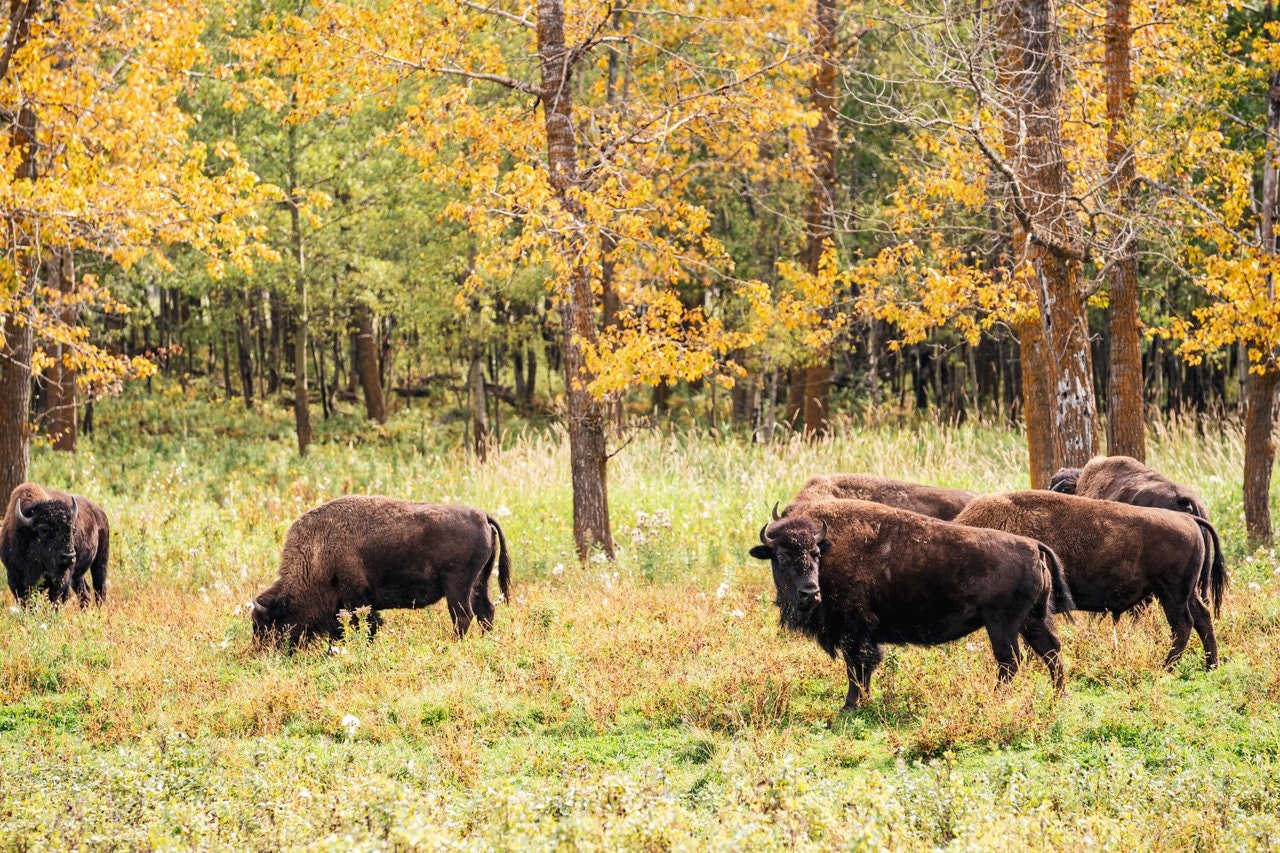
3. See bison at Elk Island National Park
No exploration of Indigenous culture would be complete without a bison sighting. Elk Island National Park, 25 miles east of Edmonton, is home to many animals including about 400 plains bison and 300 wood bison. While it's a great place to see these majestic animals, it’s also the place where they were brought back from the brink; once numbering in the tens of millions, bison were hunted to near extinction in the 19th century. The Canadian government purchased one of the last herds of plains bison and transported over 700 animals to Elk Island National Park between 1907 and 1912. The offspring from those animals helped to restore bison herds in other national parks in Canada, the USA and around the world.
4. Experience Indigenous art
If you really want to understand a specific culture, you need to explore its art. Luckily there are several places where you can experience Indigenous art in Edmonton, and înîw (pronounced EE-nu), the Indigenous Art Park, is a good place to start. Situated in Queen Elizabeth Park, the park opened in 2018, the result of a unique partnership between the City of Edmonton, Confederacy of Treaty No. 6 First Nations, the Métis Nation of Alberta, the Edmonton Arts Council and a group of talented Indigenous artists. The name of the park is a Cree word that means “I am of the Earth;” there is an engraved welcome stone and six large community art pieces to explore in the park, each telling a different story inspired by the land.
To view and purchase Indigenous fine art, visit Bearclaw Gallery, which focuses on Canadian First Nations, Inuit and Métis art including stone sculptures, paintings, wood carvings, clay works, jewelry, crafts and gifts. Whiskeyjack Art House, an Indigenous-owned and operated art gallery and boutique, is another great place to find contemporary and traditional art and artisan products. You’ll also find Indigenous art at the Art Gallery of Alberta, the province’s largest art gallery.

5. Wander the galleries of the Royal Alberta Museum
Head to The Human History Hall at the Royal Alberta Museum to view an incredible collection of Indigenous artifacts and experience the province of Alberta through the eyes of Indigenous Peoples both past and present. The Royal Alberta Museum is the largest museum in western Canada, and it holds and cares for approximately 18,000 objects of Indigenous origin dating from the mid-1800s to the present. The collection has a particular emphasis on objects and relics of Nêhiyawak (Plains Cree), Niitsitapi (Blackfoot), Dene and Métis origin, and its six galleries feature a 1,600-year-old roasting pit used by Blackfoot People, along with ceremonial clothing, beadwork and canoes. Visitors can see what life was like before European contact and after colonization, and witness the resolve of Indigenous Peoples to keep their culture alive. The Human History Hall also tells the story of early homesteaders, painting a complete picture of how Alberta developed as a province.
6. Stroll through the University of Alberta Indigenous Peoples Garden
When the University of Alberta Botanic Gardens created an Indigenous Peoples Garden in 1980, it was the first in Canada. All the plants in the garden have traditional uses in Indigenous communities – medicinal, dietary and even ornamental. For a particularly unique experience at the gardens, consider booking a Twilight Picnic from June through September. A Canadian Indigenous-inspired menu with Indigenous entertainment will be offered on select dates between June 7 - July 12.
Venture beyond Edmonton with our first-timer's guide to Alberta

7. Experience an Indigenous festival
Known as “Canada’s festival city,” Edmonton hosts more than 50 festivals annually, and the National Indigenous Peoples Day celebration during Indigenous History Month is not to be missed. Bent Arrow Traditional Healing Society provides food, live entertainment, a pipe ceremony and speakers, and many of the city's attractions put on special programs for the event; Telus World of Science Edmonton hosts a tipi raising, a smudge ceremony, tipi teachings, an Indigenous market and a free barbecue. Find events in Edmonton – and across Canada – on the official website for National Indigenous Peoples Day.
You’ll also find Indigenous celebrations at other festivals throughout the year. Indigenous filmmakers, performers and artists gather at the annual Dreamspeakers International Indigenous Film Festival, while the multi-disciplinary Rubaboo Arts Festival showcases Indigenous theater, music, dance, art and more. You’ll also find Indigenous programming at the Silver Skate Festival, Flying Canoë Volant, the Deep Freeze Festival and K Days.
Writer Liz Beatty learned the stories of Labrador's Torngat Mountains from Inuit stewards at the national park's base camp
8. Explore the Indigenous Experiences at Telus World of Science
Edmonton’s science center, the Telus World of Science, offers a variety of Indigenous educational experiences that connect Indigenous ways of knowing with contemporary science. Legends of the Northern Sky explores Indigenous knowledge and stories about the stars, while Arctic Journey delves into the people and animals of the far north through interactive exhibits. The latter includes hands-on activities like sitting in a dogsled, learning traditional dances, stepping inside an igloo and learning about ice. Visitors should also take time to check out the mural created by Indigenous artist Lance Cardinal. It’s shaped like beaver – the animal represents wisdom, one of the 7 Sacred Grandfather Teachings – and depicts Elders teaching stories based on the wisdom of the stars and the natural science of Mother Earth.
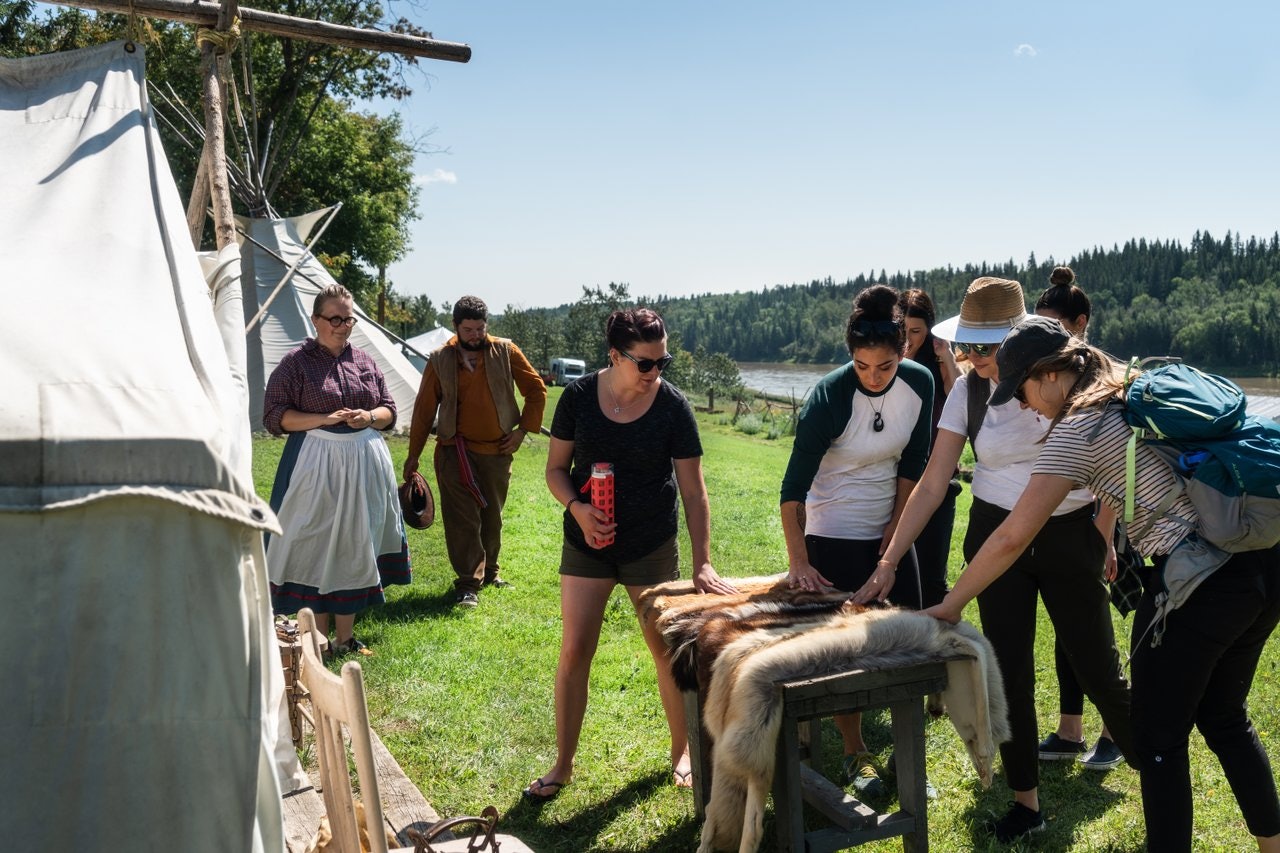
9. Visit Métis Crossing
Located about 70 miles northeast of Edmonton on the original river lots of Métis settlers, Métis Crossing is the ideal place to learn about Métis culture. Métis are people of mixed European and Indigenous ancestry with their own distinct language and culture, and one of the three recognized Indigenous Peoples in Canada. Métis Crossing has a cultural center, a restaurant and a wide variety of programming – visitors can speak with an Elder, paddle a voyageur canoe, enjoy Indigenous cuisine and participate in crafts and cultural experiences.
There’s also an onsite wildlife tour where you can see white bison, considered by many Indigenous Peoples to be the most sacred animals on the planet. Those who want to overnight here can stay in the campground, the lodge or in a sky-watching dome, where you may even get to see the northern lights. Métis Crossing also offers packages that include accommodations and special tours; the Beavers, Bison and People package includes Indigenous experiences in Edmonton, Elk Island National Park and at Métis Crossing.
10. Take a city tour with an Indigenous guide
Want to know even more about Edmonton's Indigenous history? Take a walking tour with Keith Diakiw of Talking Rock Tours – his city tour shows highlights places you might overlook when you explore on your own. For example, there’s a small green area near Edmonton's Walterdale Bridge that most visitors don’t even notice, but it holds an important history as the site of an ancient First Nations burial ground. Diakiw invites visitors to engage with this space in a respectful way by conducting a smudge ceremony, an Indigenous purification ritual.
Keep planning your trip to Alberta:
Go remote with the best of Banff and Jasper’s backcountry lodges
Add Canada's best experiences to your itinerary
Do your research with 12 things one local wants you to know about Canada
Time your adventure perfectly with the best times to visit Canada
Supported by Explore Edmonton
As a travel entertainment and inspirational media outlet, we sometimes incorporate brand sponsors into our efforts. This activity is clearly labeled across our platforms.
Funding for this story is provided by Explore Edmonton. All editorial views are those of Lonely Planet alone and reflect our policy of editorial independence and impartiality.
With sponsored content, both Lonely Planet and our brand partners have specific responsibilities:
-
Brand partner
Only provides financial support and their logo. Doesn't make revisions or approve the story.
-
Lonely Planet
We fully control the creative and editorial approach, just like any other featured story.






